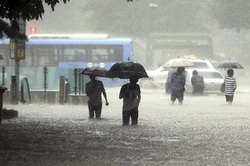 Monsoon rains in South Korea
Monsoon rains in South Korea
June 10, 2011 (found online)
I’ve been hearing that June 17th is early for the Monsoon season to begin. People are speculating about earlier arrival being connected with climate change. Travel books and guidebooks I’ve consulted over the years have said that the Monsoon season begins in July. Yet this year it began on June 17th. In casual googling to find an image to attach to this entry, I find that it began as early as June 10th in 2011!
I’ve read that the North Koreans chose to begin their offensive on June 25th of 1950 specifically with the Jang-Ma in mind. They wanted the critical first week of the war to be before the Monsoon season began. This would give them at least a week of good weather to capture Seoul and “bag” much of the South-Korea Army near the 38th parallel (both happened). The point is, NK planners were confident the Jang-Ma would come only in July. [In July 1950, when the Jang-Ma arrived, the pace of the NK offensive slowed considerably. I’ve read reports of the early U.S. battles, including the disastrous July-1950 defense of Daejeon. It ended not only in U.S. defeat/retreat, but with the capture of the U.S. general in command. U.S. accounts report near-daily, steady rain at that time. / Why did NK not attack earlier, if their aim was to avoid the Jang-Ma? As far as I’ve read, they were getting all their ducks in order, vis-a-vis (1) Their recently-acquired T-34 tanks, and (2) the integration of the tens of thousands of crack Korean veterans of Mao Zedong’s People’s Liberation Army who’d been streaming back into Korea from late-’49 to mid-’50.]
A good thing, many said, was its cooling effect. Korean summer can be oppressively hot. The next few days call for clear skies and hot, around 85-90 Fahrenheit during the day (30 C and up). The next time ol’ Mr. Jang-Ma passes through, it’ll push the temperature down to the 70s or even high 60s! [20 C range].

Comments closed due to excessive spam targeting this old post.